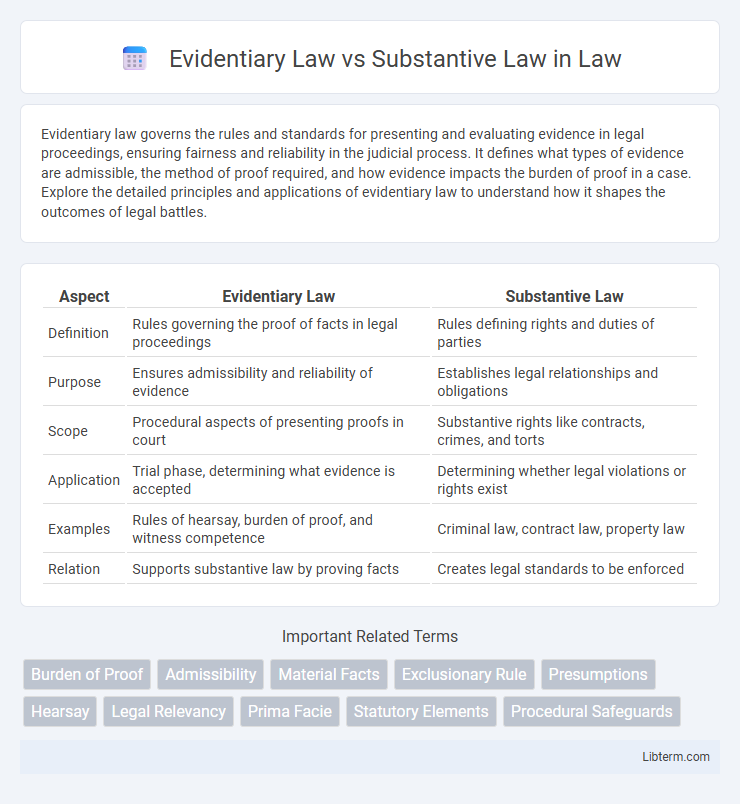Evidentiary law governs the rules and standards for presenting and evaluating evidence in legal proceedings, ensuring fairness and reliability in the judicial process. It defines what types of evidence are admissible, the method of proof required, and how evidence impacts the burden of proof in a case. Explore the detailed principles and applications of evidentiary law to understand how it shapes the outcomes of legal battles.
Table of Comparison
| Aspect | Evidentiary Law | Substantive Law |
|---|---|---|
| Definition | Rules governing the proof of facts in legal proceedings | Rules defining rights and duties of parties |
| Purpose | Ensures admissibility and reliability of evidence | Establishes legal relationships and obligations |
| Scope | Procedural aspects of presenting proofs in court | Substantive rights like contracts, crimes, and torts |
| Application | Trial phase, determining what evidence is accepted | Determining whether legal violations or rights exist |
| Examples | Rules of hearsay, burden of proof, and witness competence | Criminal law, contract law, property law |
| Relation | Supports substantive law by proving facts | Creates legal standards to be enforced |
Introduction to Evidentiary Law and Substantive Law
Evidentiary law governs the rules and principles that determine what evidence is admissible in a court of law, aiming to ensure a fair and accurate trial process. Substantive law defines the rights and duties of individuals and the legal relationships between them, establishing the legal grounds for claims and defenses. Understanding the distinction between evidentiary and substantive law is crucial for navigating legal proceedings effectively, as one addresses proof and procedure while the other outlines the laws themselves.
Defining Evidentiary Law
Evidentiary Law governs the rules and standards by which evidence is collected, presented, and evaluated in legal proceedings to ensure fairness and reliability. It determines the admissibility, relevance, and weight of evidence, shaping how facts are proven or disproven in court. Unlike Substantive Law, which defines rights and duties, Evidentiary Law focuses on procedural mechanisms that facilitate the fact-finding process.
Understanding Substantive Law
Substantive law defines the rights and duties of individuals and entities, establishing the legal framework that governs behavior and relationships. It encompasses laws related to contracts, property, torts, criminal offenses, and civil rights, providing the foundation for legal claims and defenses. Understanding substantive law is essential for determining the legal basis of a case and the outcomes that the law seeks to achieve.
Key Differences Between Evidentiary and Substantive Law
Evidentiary law governs the rules and standards for presenting and admitting evidence in a court of law, ensuring the reliability and relevance of information during trials. Substantive law defines the legal rights and obligations of individuals and entities, establishing the framework for determining the outcome of legal disputes. The primary difference lies in evidentiary law's focus on proof and procedure, while substantive law centers on the actual rights, duties, and liabilities under the law.
Purpose and Scope of Evidentiary Law
Evidentiary law governs the rules and standards for presenting and evaluating evidence in legal proceedings, ensuring the reliability and admissibility of proof to establish facts. Its scope includes regulating the types of evidence permitted, methods of collection, and the burden of proof necessary to support claims within both criminal and civil cases. Unlike substantive law, which defines the rights and obligations of parties, evidentiary law focuses solely on the procedural mechanisms that determine how those rights and obligations are proven in court.
Role of Substantive Law in Legal Proceedings
Substantive law defines the rights and duties of individuals and governs how courts must apply legal principles in specific cases, shaping the outcomes of legal disputes. It establishes the framework for determining what constitutes a legal wrong or breach, providing the basis for claims, defenses, and liabilities. In legal proceedings, substantive law guides judges and juries in evaluating facts against established legal standards to reach fair and just decisions.
Examples of Evidentiary Law in Practice
Evidentiary law governs the rules and principles that determine the admissibility, relevance, and weight of evidence presented in court, such as the Federal Rules of Evidence used in U.S. courts. Examples include rules on hearsay, where out-of-court statements are generally inadmissible unless they meet specific exceptions, and the exclusion of illegally obtained evidence under the "fruit of the poisonous tree" doctrine. These rules contrast with substantive law, which defines legal rights and duties, such as criminal statutes or contract laws.
Illustrations of Substantive Law in Action
Substantive law governs the fundamental rights and duties of individuals, such as property ownership, contracts, and criminal offenses, illustrating its role through defining legal relationships and obligations. For example, a contract dispute involves substantive law determining the validity and enforcement of agreements, while criminal law outlines offenses like theft and corresponding penalties. These scenarios demonstrate substantive law's essential function in shaping legal outcomes by establishing rules that govern behavior and rights.
Interplay Between Evidentiary and Substantive Law
The interplay between evidentiary law and substantive law shapes the framework for legal decisions by defining the rules governing proof and the rights and duties of parties. Evidentiary law determines the admissibility, relevance, and weight of evidence that supports the substantive law claims, ensuring fair trial procedures. Effective application of evidentiary rules directly influences the enforcement and interpretation of substantive legal principles in judicial proceedings.
Conclusion: Importance in the Legal System
Evidentiary law governs the rules and standards for presenting and evaluating proof in legal proceedings, ensuring that only relevant and reliable evidence influences judicial decisions. Substantive law defines the rights and duties of individuals and the legal grounds for claims and defenses in a case. The distinction is crucial for the legal system because evidentiary law safeguards fairness and accuracy in trial outcomes, while substantive law establishes the legal framework for justice and societal order.
Evidentiary Law Infographic

 libterm.com
libterm.com